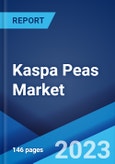Kaspa peas are a high yielding semi-leafless dun-type field pea belonging to the same sub-species as green peas. They consist of various digestible nutrients, which make them excellent for human consumption and livestock feed. Kaspa peas are suitable for cultivation in areas receiving more than 400mm of average annual rainfall. Also, these peas are easier to harvest than trailing-type varieties as their pods are held above the ground level even when the crop lodges. They have shatter-resistance pods which help in reducing grain loss if harvesting is delayed or even poor conditions exist at the time of crop maturity. Nowadays, many split pea processing companies prefer uniform and round dun peas due to their higher splitting efficiency.
Increasing health consciousness among consumers is one of the key factors driving the market growth. Kaspa peas are a rich source of proteins, fibers, iron, folate and potassium. The high amounts of nutrients present in these peas offer various health benefits to consumers. The iron found in kaspa peas prevents chances of anemia and promotes healthy blood hemoglobin levels. On the other hand, dietary fibers play an essential role in improving digestion and lowering blood cholesterol levels. These peas, along with other legumes, offer a cheap source of nourishment, especially in the South Asian region. As a result, they serve as a popular snack in several South Asian countries, including the southern belt of India. Moreover, the increasing population and the expanding food sector, particularly in the developing regions, are also creating a positive impact on the industry. The introduction of new varieties of field peas targeting niche and specialty markets are providing vast opportunities to the existing players in the industry, thus further driving the market.
Key Market Segmentation:
The report provides an analysis of the key trends in each sub-segment of the global kaspa peas market report, along with forecasts at the global and country level from 2024-2032.Regional Insights:
CanadaChina
Russia
United States
India
Others
On the geographical front, Canada represents the largest producer of kaspa peas, accounting for nearly a third of the total global production.
Competitive Landscape:
The competitive landscape of the market has also been analyzed in the report, covering the detailed profiles of the numerous small and large manufacturers who compete in terms of prices and quality.Key Questions Answered in This Report:
How has the global kaspa peas market performed so far and how will it perform in the coming years?What has been the impact of COVID-19 on the global kaspa peas market?
What are the various stages in the value chain of the industry?
What are the key driving factors and challenges in the industry?
What is the structure of the industry and who are the key players?
What is the degree of competition in the industry?
What are the profit margins in the industry?
What are the key requirements for setting up a kaspa peas processing plant?
How are kaspa peas processed?
What are the various unit operations involved in a kaspa peas processing plant?
What is the total size of land required for setting up a kaspa peas processing plant?
What are the machinery requirements for setting up a kaspa peas processing plant?
What are the raw material requirements for setting up a kaspa peas processing plant?
What are the packaging requirements for kaspa peas?
What are the transportation requirements for kaspa peas?
What are the utility requirements for setting up a kaspa peas processing plant?
What are the manpower requirements for setting up a kaspa peas processing plant?
What are the infrastructure costs for setting up a kaspa peas processing plant?
What are the capital costs for setting up a kaspa peas processing plant?
What are the operating costs for setting up a kaspa peas processing plant?
What will be the income and expenditures for a kaspa peas processing plant?
What is the time required to break-even?
Table of Contents
Methodology

LOADING...
Table Information
| Report Attribute | Details |
|---|---|
| No. of Pages | 147 |
| Published | July 2024 |
| Forecast Period | 2023 - 2032 |
| Estimated Market Value in 2023 | 26.6 Million Tons |
| Forecasted Market Value by 2032 | 47.5 Million Tons |
| Compound Annual Growth Rate | 6.7% |
| Regions Covered | Global |









